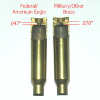I was loading some .308's the other day. I do one of two things, either purchase cases through the internet, or, if I find some at the range, pick 'em up and reload them too. Anyway, I'm sizing some cases, so I grabbed a handful of FC, and thought I'd size them up too.
Sized some R&P, PPM, Winchester and FC. No problems - everything went fine, checked all with a case gauge amd for setback using my Stony Point gauge and they were all identical. Loaded them up with 44.5g of Varget under a 168g Nosler HPBT and a WLR primer. All were trimmed using a Possum Hollow trimmer. Took them to the range and everything went fine till I got to the FC. Fired ok, but had to take a block of wood and whack the bolt in order to get it to extract. It lifted fine, just wouldn't pull out. I checked the primer and no signs of pressure at all, so I tried another one - same problem. OK - somethings different. Fired the other brass and took the rest of the FC home.
Got home, pulled the bullets and weighed the charges - all exactly at 44.5. Measured the wall thickness and found it to be between .001 to .0015 larger than the other brass. OK - thicker walls, less capacity, same powder = more pressure. I reduced the load to 43.5 of Varget and loaded up a few. Took them to the range and same problem - would not extract.
I even tried nexk sizing some of them but the problem persists. I'm thinking the brass expands but doesn't contract. Maybe they need anealing? I have no other ideas other than scrap the FC cases and don't worry about it. Everything else shot like a champ - just the FC cases were giving me problems.
What has been your experience using FC brass? I use if for .223 with zero problems. I'm strongly leaning towards the cases were work hardened and consequently didn't contract, although I'm open to any suggestions you might have.
Thanks all......
Sized some R&P, PPM, Winchester and FC. No problems - everything went fine, checked all with a case gauge amd for setback using my Stony Point gauge and they were all identical. Loaded them up with 44.5g of Varget under a 168g Nosler HPBT and a WLR primer. All were trimmed using a Possum Hollow trimmer. Took them to the range and everything went fine till I got to the FC. Fired ok, but had to take a block of wood and whack the bolt in order to get it to extract. It lifted fine, just wouldn't pull out. I checked the primer and no signs of pressure at all, so I tried another one - same problem. OK - somethings different. Fired the other brass and took the rest of the FC home.
Got home, pulled the bullets and weighed the charges - all exactly at 44.5. Measured the wall thickness and found it to be between .001 to .0015 larger than the other brass. OK - thicker walls, less capacity, same powder = more pressure. I reduced the load to 43.5 of Varget and loaded up a few. Took them to the range and same problem - would not extract.
I even tried nexk sizing some of them but the problem persists. I'm thinking the brass expands but doesn't contract. Maybe they need anealing? I have no other ideas other than scrap the FC cases and don't worry about it. Everything else shot like a champ - just the FC cases were giving me problems.
What has been your experience using FC brass? I use if for .223 with zero problems. I'm strongly leaning towards the cases were work hardened and consequently didn't contract, although I'm open to any suggestions you might have.
Thanks all......



